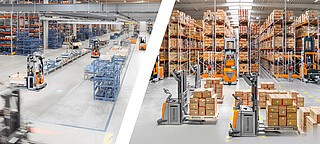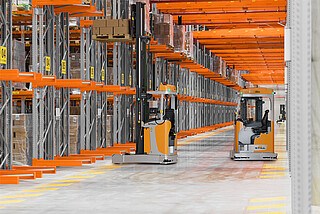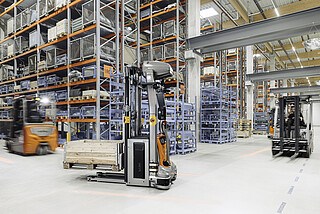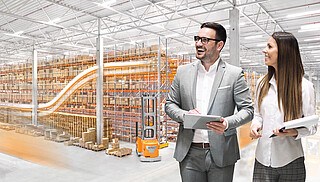Automation without bias

Automation solutions have long been an integral part of the logistics industry. And yet there are a number of myths and preconceptions about the technology that make many companies hesitate. Dr Florian Heydenreich, Managing Director Sales & Service STILL EMEA, dispels the most common misconceptions and explains what really matters when it comes to successful automation projects.
Automation in intralogistics is no longer a topic for the future - it is already here and a reality in many warehouses. However, it is still difficult for many companies to understand. The technology is complex and there are many different solutions and suppliers. In addition, hardware and software are constantly evolving. "When we talk to customers, we often hear the same myths and misconceptions about automation," says Dr Florian Heydenreich.
Myth 1: High initial investment and new buildings
Many companies shy away from automating their processes, believing that it can only be done with huge investments and in purpose-built facilities. The reality is different, however. The technology has evolved significantly in recent years and now offers much more flexible solutions. "Automation is very easy to implement in existing warehouses," says Heydenreich. The introduction of automation does not have to start with a complete reorganisation of all processes: "Our solutions are scalable. Companies can start with individual process steps and then gradually build up automation." This allows a controlled transition with manageable risk and the opportunity to gain experience before making larger investments. Together with the customer, STILL identifies strategically important processes where automation offers the greatest added value. "This step-by-step approach not only reduces the financial risk," says Heydenreich: "It also facilitates employee acceptance and enables continuous learning."

Myth 2: Less reliable than experienced workers
"Especially in companies where logistics is not the core business, we still sense a certain fundamental scepticism towards automation solutions," says Heydenreich. This is particularly true of companies whose logistics processes supply production. The fear is that if the technology fails, in the worst case the entire production process will come to a standstill. "Such concerns are understandable, but they no longer reflect the state of the art," explains Heydenreich: "Modern automation systems are highly available, fail-safe and reliable. We guarantee this through standardised processes, comprehensive training concepts and clearly defined service structures."

The key to success lies in the right preparation: "A structured automation process always begins with close cooperation between us and the customer," says Heydenreich: "Only when the framework conditions are precisely identified and all requirements are taken into account can the automation solution unfold its full potential." With a reliability rate of 98 to 99 per cent, STILL's automation solutions are at a very high level. This is because manual operations are not necessarily more reliable: they are affected by sick leave, staff fluctuations or human error, for example. In addition, automated systems work around the clock with consistent precision and speed.
Myth 3: The technology is not yet mature
As mentioned at the beginning, automation in intralogistics is no longer just a topic for the future. However, this realisation has not yet reached everyone; many companies are hesitant and may want to wait for further developments in the technology before opting for automation. "The technology is ready," underlines Heydenreich. The key is to get the planning right. "The biggest risk to a successful automation project is the human element."
This statement may come as a surprise, but it illustrates a key point: The technical solutions to most logistical challenges already exist and have been proven in numerous applications.

The real challenge is to implement and adapt the processes correctly. This starts with a detailed description of the general conditions: What exactly needs to be automated? How does the ideal process differ from the reality in the warehouse? How many different load carriers are there? What interfaces with other systems need to be considered? "Once automation has been implemented, it is more difficult and therefore more expensive to add exceptions to the system. It is therefore essential to define the process in detail at the outset," explains Heydenreich.
Myth 4: Traditional providers are not innovative enough
Automating intralogistics processes is no longer a new idea. As a result, many automated solutions are already based on standardised ideas. This leads some customers to conclude that traditional suppliers are not innovative enough. A false conclusion, as Heydenreich explains: "Innovative thinking is definitely the key to successful automation projects. But innovation requires the right standards." A standardised approach makes the implementation of automation solutions reliable and robust. "This balance between innovation and standardisation is crucial to developing sustainable solutions. In addition, it is important to ensure that the innovative technology can be practically applied to different use cases and maintained over the long term.
"Automation is not a product, it's a project," says Heydenreich: "At STILL, we have decades of experience and a wide range of expertise to provide our customers with the best possible support." In addition, there are numerous specialists and service technicians who ensure that systems are implemented smoothly and supported reliably. "This infrastructure enables us to successfully implement and support automation projects over the long term in all countries, in all languages and in almost all warehouse environments," Heydenreich stresses.
Myth 5: Automation projects are purely contract projects
For many companies, the idea of starting with automation is like this: The customer hires a service provider, who then implements the automation independently. "This is not the reality," says Heydenreich: "Automation is always a joint endeavour." The customer brings specific knowledge of its processes, products and requirements, while the service provider brings technical expertise and experience from similar projects. Successful implementation requires the expertise of both the customer and the service provider. At the same time, it is often important to manage change. In other words, classic change management: "It's not just about one-to-one automation of manual processes, but changing them in such a way that the automation can achieve its full potential," explains Heydenreich.

A successful automation project therefore requires close cooperation between all parties involved. This includes not only the technical experts on both sides, but also the people who will be using the automated systems. Involving them at an early stage promotes acceptance and ensures that the practical aspects of day-to-day operations are taken into account. "At STILL, we therefore integrate on-site employee training into the process at an early stage," says Heydenreich. Companies can only reap the full benefits of automation if everyone involved works together.
Automation: A strategic competitive advantage
The analysis of common myths about automation shows that many reservations are based on outdated ideas or individual experiences that no longer reflect the current state of the art. Today's automation solutions are more flexible, scalable and reliable than ever before. They offer companies the opportunity to make their logistics processes more efficient, reduce costs and improve quality at the same time. "Those who see automation as a joint project and are prepared to take a close look at their own processes are best placed to implement it successfully," says Heydenreich.
Contact request
Subscribe to the Newsletter !
Always up to date with STILL: Subscribe to the STILL newsletter and we will inform you regularly about interesting industry topics.
